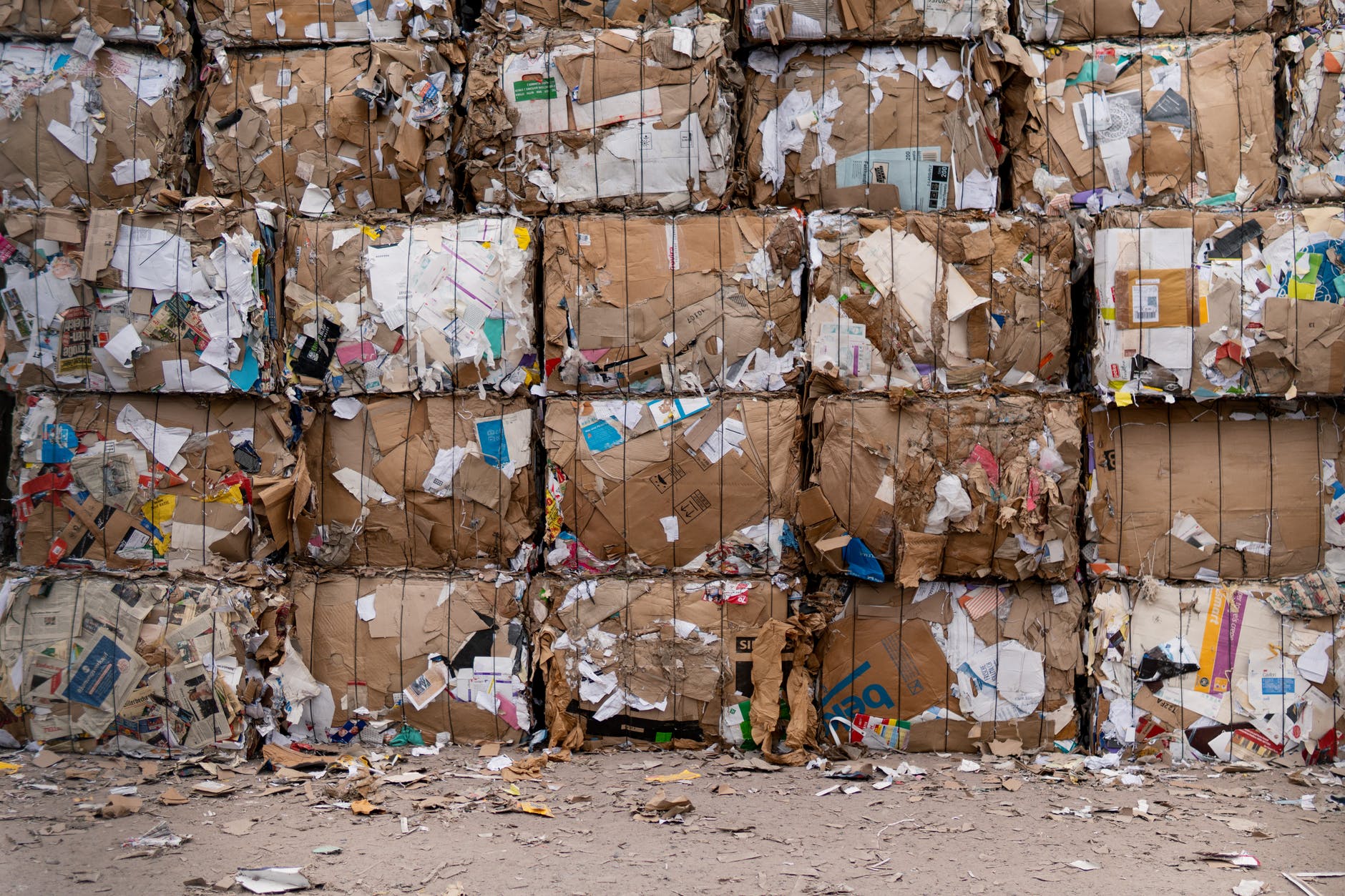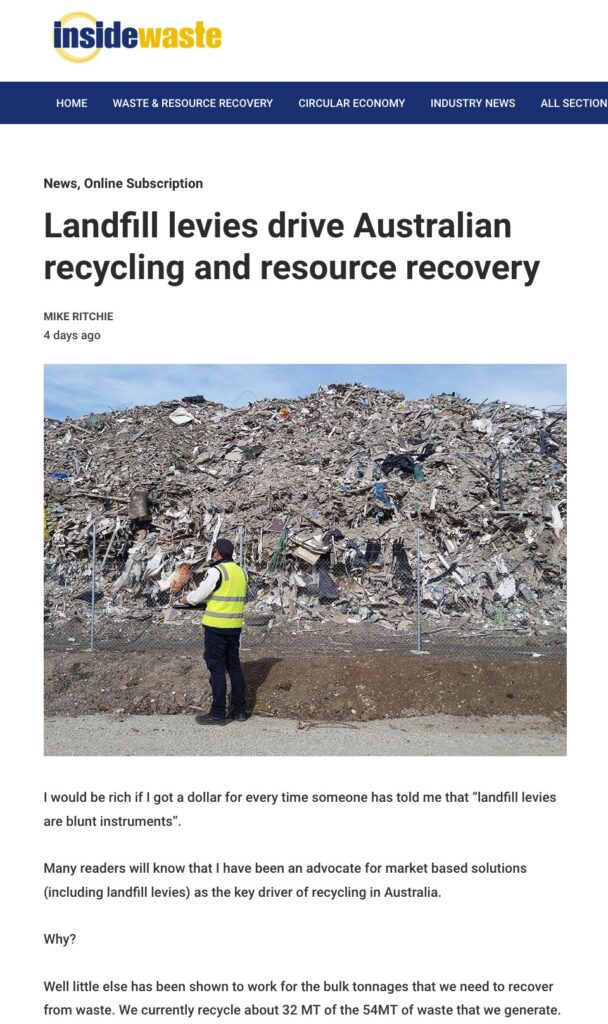Landfill levies drive Australian recycling and resource recovery
By: Mike Ritchie, MRA Consulting Group

I would be rich if I got a dollar for every time someone has told me that “landfill levies are blunt instruments”.
Many readers will know that I have been an advocate for market based solutions (including landfill levies) as the key driver of recycling in Australia.
Why?
Well little else has been shown to work for the bulk tonnages that we need to recover from waste. We currently recycle about 32 MT of the 54MT of waste that we generate.
All of that 32 MT is recovered now because it:
- Has economic value (think cardboard, steel, aluminium);
- It is subsidised by someone to have it recycled (think mixed kerbside recycling, commercial commingled containers); or
- It is cheaper to recycle it than to landfill it (think organics).
Try to think of a material stream that is recovered for reasons other than those above. Sure you might be able to think of some minor stream in a particular niche situation but does it deliver tonnes at scale?
Governments drive recycling. It is a highly regulated market. Targets drive government policy.
Once they have decided the strategic direction and speed (via Targets) governments have only 3 levers they can pull:
- Market pricing (levies, cap and trade etc) to make recycling commercially viable;
- Regulations (bans or mandated collections etc) to drive materials out of landfill; and
- Education to try to motivate people to “do the right thing”.
Education works at the margins but it requires the systems to be in place. The systems for recycling are only put in place where options 1) or 2) are met. Someone has to be paid to set up the recycling system. To collect the material, to sort it, to wash and purify it and finally to return it to the productive economy. That costs money.
If companies or Councils can’t either make money or save money by recycling, by and large they won’t do it.
Yes I hear some of you say there are those examples of companies voluntarily recycling stuff at a cost to themselves because they are ‘responsible’ or to obtain brand value etc. True, but in my experience these represent less than 5% of businesses.
Volunteerism will not get us to the 80% diversion from landfill by 2030 target that has been agreed by all Governments as part of the National Waste Action Plan. Education will not drive the tonnes out of landfill.
Tweet
Governments have to make the tough decisions to either price landfills fully (to cover all of their externality costs and scarcity value) via levies or cap and trade schemes, or ban waste materials to landfill (such as Europe has done for organics).
Recent work done by the MRA team proves the point.
The graph below shows the relationship between recycling rates across Australia and the magnitude of landfill levies.

It shows a very clear relationship.
Landfill levies clearly drive recycling. (So do bans but Governments have shown no appetite for regulating what can go to landfill).
The R2[1] shows that landfill levies explain over 70% of the variability of the curve.
States with high landfill levies have high resource recovery rates.
States with low landfill levies have low recovery rates.
The logic is of course, very simple (blunt).
If a generator of waste has a binary decision to make “Do I landfill this or recycle it?” price makes a big difference. If it is cheaper to recycle it, they will. If it is cheaper to landfill it, they will.
Ask any waste contractor and they will tell you this is the fundamental law of waste management.
To get to 80% diversion from landfill, we need to make the answer to that question simple and ever present.
We need to make recycling the default option rather than landfill. Today landfill is still cheaper than recycling for many waste streams and in most locations (particularly rural Australia).
Before you jump on me about the negative impacts of further levy increases I would make these points:
- The increased landfill levies should be used to fund recycling;
- They should be hypothecated as much as possible; and
- They should offset other regressive taxes (e.g. payroll tax) where they are not hypothecated.
Nobody likes paying higher taxes but we also don’t need to. We need States to progressively raise landfill levies to signal their intentions to make recycling viable. We need them to hypothecate much of the increases (at least in the medium term) to supporting Council and commercial recycling activities and then we need them to reduce other taxes by the equivalent amount.
Landfill levies currently raise over $1.5b/year for State Governments. Further increases will send the right market signals but the revenue earned needs to be spent on recycling or at the very least offsetting other relevant taxes.
But it is important to point out that it is the magnitude of the levy (the market price) that does the heavy lifting in driving tonnes from landfill and into recycling, NOT the expenditure of the levy funds via grants. Grants and subsidies from levy funds are the cream on the pie but the real value of levies is in the price signal – making landfill gate fees more expensive than recycling. That drives the answer to the question “Could I be bothered recycling this, or not?”.
That is how we use the market to get to an 80% diversion from landfill target.
Blunt yes but achievable and realistic. Nothing else will get us there either in time or at scale.
Simple. Market economics.
Mike Ritchie, is the Managing Director of MRA Consulting Group.
[1] R2 is used to measure the strength of the causal relationship between two quantitative variables (X variable being the Levy rate, Y variable being the Recovery Rate). The closer the R2 value is to 1, the stronger the positive causal relationship between the Levy and Recovery Rate. Meaning that the data fits the regression model. The closer the R2 value is to 0, the weaker the causal relationship is between the Levy and Recovery Rate.
This article has been published by the following media outlets:




